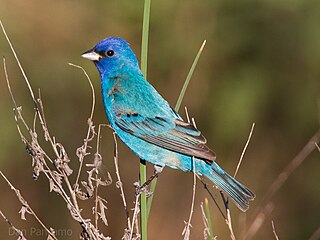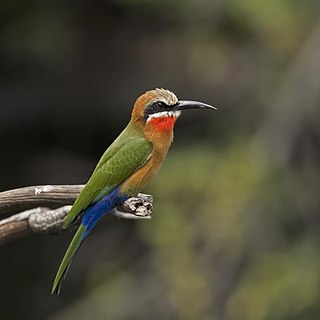
Ornithology is a branch of zoology that concerns the study of birds. Several aspects of ornithology differ from related disciplines, due partly to the high visibility and the aesthetic appeal of birds. It has also been an area with a large contribution made by amateurs in terms of time, resources, and financial support. Studies on birds have helped develop key concepts in biology including evolution, behaviour and ecology such as the definition of species, the process of speciation, instinct, learning, ecological niches, guilds, island biogeography, phylogeography, and conservation.

The song thrush is a thrush that breeds across the West Palearctic. It has brown upper-parts and black-spotted cream or buff underparts and has three recognised subspecies. Its distinctive song, which has repeated musical phrases, has frequently been referred to in poetry.

Bird migration is a seasonal movement of birds between breeding and wintering grounds that occurs twice a year. It is typically from north to south or from south to north. Migration is inherently risky, due to predation and mortality.

The whooping crane is an endangered crane species, native to North America, named for its "whooping" calls. Along with the sandhill crane, it is one of only two crane species native to North America, and it is also the tallest North American bird species. The whooping crane's lifespan is estimated to be 22–24 years in the wild. After being pushed to the brink of extinction, due to unregulated hunting and loss of habitat, and just 21 wild cranes remaining by 1941, conservation efforts would lead to a partial recovery. The total number of cranes in the surviving migratory population, plus three reintroduced flocks and in-captivity, only slightly exceeds 800 birds as of 2020.

The indigo bunting is a small seed-eating bird in the cardinal family, Cardinalidae. It is migratory, ranging from southern Canada to northern Florida during the breeding season, and from southern Florida to northern South America during the winter. It often migrates by night, using the stars to navigate. Its habitat is farmland, brush areas, and open woodland. The indigo bunting is closely related to the lazuli bunting and interbreeds with the species where their ranges overlap.
The Migratory Bird Treaty Act of 1918 (MBTA), codified at 16 U.S.C. §§ 703–712, is a United States federal law, first enacted in 1918 to implement the convention for the protection of migratory birds between the United States and Canada. The statute makes it unlawful without a waiver to pursue, hunt, take, capture, kill, or sell nearly 1,100 species of birds listed therein as migratory birds. The statute does not discriminate between live or dead birds and also grants full protection to any bird parts, including feathers, eggs, and nests. A March 2020 update of the list decreased the number of species to 1,093.

Zugunruhe is the experience of migratory restlessness.

The Kinks, an English rock band, were active for over three decades, from 1963 to 1996, releasing 26 studio albums and four live albums. The first two albums are differently released in the UK and the US, partly due to the difference in popularity of the extended play format, and partly due to the US albums including the hit singles, and the UK albums not; after The Kink Kontroversy in 1965 the albums were the same. Between 100 and 200 compilation albums have been released worldwide.

The National Wildlife Refuge System in the United States has a long and distinguished history.

Wildlife rehabilitation is the process of caring for injured, sick, orphaned, or displaced wild animals with the goal of releasing them back into their natural habitat. It involves medical treatment, temporary housing, and specialized care for a variety of species, from birds and mammals to reptiles and amphibians. Wildlife rehabilitation combines veterinary science, wildlife conservation, and animal welfare to ensure that animals have the best chance for recovery and survival after facing challenges such as injury, disease, or human interference.

The white-fronted bee-eater is a species of bee-eater widely distributed in sub-equatorial Africa.

Toxostoma is a genus of bird in the family Mimidae. This genus contains most of the birds called thrashers, and accordingly members of this genus are sometimes referred to as the "typical thrashers".
The Institute for Bird Populations (IBP), based in Petaluma, California is a non-profit organization dedicated to studying and monitoring bird populations, and providing land managers and policy makers with information needed to better manage those populations.
Jean Desbouvrie was a French amateur bird trainer who believed that swallows could be put to use for military communications. During the late 19th century Desbouvrie persuaded the government of France to conduct a study on the feasibility of using swallows as messengers. His early demonstrations showed that swallows could exhibit homing behavior and that when they did so they flew much faster than homing pigeons. Desbouvrie also succeeded in curbing the birds' natural migratory behavior. After obtaining authorization from the government for follow-up testing, Desbouvrie delayed and did not follow through with rigorous experimentation.

Bird trapping techniques to capture wild birds include a wide range of techniques that have their origins in the hunting of birds for food. While hunting for food does not require birds to be caught alive, some trapping techniques capture birds without harming them and are of use in ornithology research. Wild birds may also be trapped for their display in captivity in zoological gardens or for keeping as a pet. Bird trapping was formerly unregulated, but to protect bird populations most countries have specific laws and regulations.

Khandoli Dam is a dam located 10 km North-East of Giridih town towards Bengabad in Jharkhand, India. Khandoli is also an important tourist spot at the foot of the Khandoli hill. The reservoir of the Khandoli dam provides water supply to more than one lakh residents of the Giridih city.
The Margaret Morse Nice Medal is an ornithological award made annually by the Wilson Ornithological Society (WOS). It was established in 1997 and named in honour of ornithologist Margaret Morse Nice (1883–1974). The medal recipient is expected to give the plenary lecture at the WOS annual general meeting.
Rudolf Karl Theodor Drost was a German ornithologist best known for his studies on bird migration conducted at the Heligoland observatory.
Emlen is a given name and a surname. Notable people called Emlen include:













